Type of Casts
Backhand Cast
The backhand cast is useful for casting on the opposite side of your body. Instead of switching the rod from the dominant hand to the other hand, the dominant hand is employed throughout the cast. Most right handed casters have difficulty casting left handed. Many times a wind or an obstruction limits one-sided casting; for example, a stiff breeze blown onto the right side of a right handed caster blows the line onto the caster. It’s corrected by either casting left handed or by using this backhand cast. Also, an obstruction like a tree on your right side limits your casting stroke from being completely done on your left side.
Remaining on the caster’s dominant side, the rod is raised over the head high enough and tilted so the casting planes are performed across. The rod tip and line now pass on your backhand side. A normal casting stroke is used except the rod hand
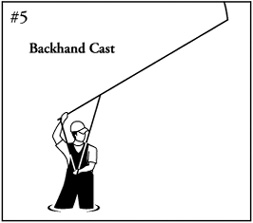
position is one that’s similar to brushing your hair. Away from your body the line passes safely, although sloppy casts and some widened loops may pass the line close to your body. (See Diagram 5)
The backhand cast is ideal for avoiding both wind and obstructions on your casting hand’s side.
Reach Cast
The reach cast is perhaps the most useful cast for stream fishing. It provides
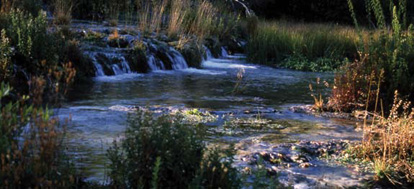

an aerial mend which enhances a drag free drift.
Simply, the reach cast is made just after the forward cast stops by reaching the rod into the direction that you want the line belly to travel. Keep enough tension on back of the loop so it maintains enough momentum to reposition the line belly. The power stroke’s hard stop directs the loops towards the target. Only the line belly close to the caster is redirected. (See Diagram 6) The final forward cast should be aimed slightly higher and somewhat overpowered than usual. These modifications enhance the fly’s ability to reach the target and cause the line belly to be favorably repositioned. As the line straightens out in front of you, keep the rod tip held high above your head. Just as the line begins to turn over, reach the rod into the desired direction. Reach as far as you can, then simultaneously drop the rod tip and line to the water.
An upstream reach cast is useful when casting from fast to slower currents.
In summary, the reach cast is simply an aerial mend allowing the line belly to land in a more favorable location to enhance a longer drag free float.
Tuck Cast
The tuck cast is used for drag free floats in difficult eddies and for quickly sinking a weighted fly; consequently, in the tuck cast the fly lands first with the leader heaped up on top of it.
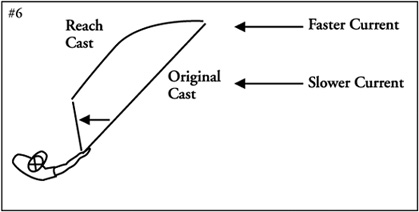
Simply, the tuck cast is made by overpowering a higher-than-normal forward cast by abruptly stopping it. Put some speed into the tight looped cast, so the fly turns over and then under the leader, landing the fly first. The slacked leader piled onto the fly allows the fly to sink freely and to drift longer without drag.
Wind resistant bushy flies are awkward to turn over, but the tuck cast readily turns over sparsely tied flies. (See Diagram 7)
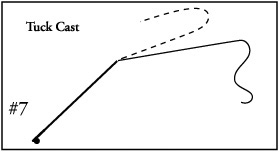
Roll Cast
The roll cast is useful when you lack the open space for a backcast. Instead of making a backcast, build momentum by rolling the line in an over motion that replaces the backcast stroke.
To perform the roll cast, the rod is smoothly lifted back to the backcasting stroke (9:00 or 10:00 o’clock position) by slowly moving the line. The line is straightened and a widened loop is formed. While it still lies on the water’s surface, power this loop forward by a casting stroke which energizes the loop into unrolling and making a lengthened cast. The same forward cast is made complete with a short, smooth, accelerating, straight elbow path, and a sudden stop. The only modification is the gentle backcast stroke designed to straighten the line and to form a wide loop. (See Diagram 8) Remember to draw the loop far back from your shoulder.
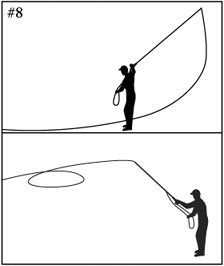
It’s best to practice the roll cast on water; a grass surface creates line drag that dampens the cast.
Sidearm Casting
Sidearm casting is useful for fishing in windy conditions and for casting under overhanging vegetation. Additionally, it’s helpful in avoiding other anglers when fishing from restricted areas such as a drift boat. Since wind and overhanging vegetation is ubiquitous, the sidearm cast is frequently used.
Sidearm casting readily throws a curved line and leader; furthermore, such a curved cast is useful in reducing the effects of drag. Both positive and negative curves can be created. Positive curves are created by overpowering the sidearm casting stroke; negative curves are caused by under powering the delivery. In addition, a hard stop can create a positive curve, and a soft stop can make a negative curve.
The sidearm cast uses the same casting strokes and principals as the overhead cast; these strokes are just completed on a tilted side plane.
Wind has less velocity the closer it approaches the water and ground. In these leeward areas the sidearm cast is more efficient. Sidearm casting in these lower areas of less wind results in efficient casting. Also, a sidearm cast can place the fly underneath an overhanging tree branch to reach a prime lie.
Different degrees of sidearm casting can be employed. I use a slight degree during all of my overhead casts because it keeps the false cast fly 6-8 feet safely away from me. I continually employ the sidearm cast at windy times and at covered areas.
Wind Casting
Along with the sidearm cast there are some other tips for casting on windy days. Use the tightest fastest loops that you can cast because they are less wind resistant. Also, I prefer to cast smaller diameter lines. Once I fished my two wt. outfit on an extremely windy day on the lower Henry’s Fork River. I was amazed at how well it performed. My favorite windy day outfit is a fast action 4 wt. rod and a 4 wt. line. With this outfit I can create narrow fast loops which cut through the wind more effectively than my 7 and 8 weight outfits. I guess it’s easier to toss a softball than a volley ball on a windy day.
Angle the casting planes to take advantage of the wind. For example, when casting into the wind angle the backcast high where the wind will help straighten it out; then, direct the forward cast downwards toward the surface where there is less wind. (See Diagram 9)
Casting with the wind aids the forward cast and hinders the backcast. Since the line must be straightened before it can be cast, restrict the backcast to shorter lengths and shoot more line on the forward cast. Again, angle the shortened backcast low into the wind and angle the forward cast up higher to use the wind to help shoot the line.
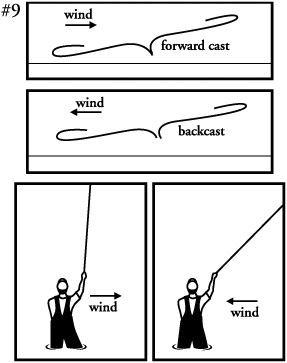
Unsnagging Roll Cast
The unsnagging roll cast is used in an attempt to pull against a snagged fly from the opposite direction.
Once snagged, pull some additional line out and overpower a roll cast forcing the line to roll in back of the snagged fly. Then make a quick forceful backcast stroke which enhances this backwards pull. Hopefully these two motions will dislodge the fly. If successful, inspect the hook and tippet for damage. (See Diagram 10)
This unsnagging roll cast works some of the time, but many snagged flies are just too securely hooked and will be lost.
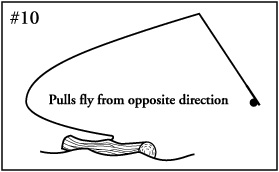

© 2025 The Gale Group, Inc. All rights reserved.
© 2025 Perigee Learning LLC. All rights reserved.
LoveTheOutdoors.com is owned and operated by Advameg, Inc. © 2025 Advameg, Inc.
Camping Adventures • Dutch Oven Cooking • Sports Knots
Fly Tying • Freshwater Fishing • Fly Fishing

